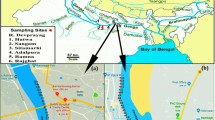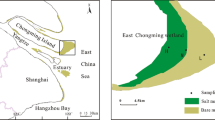Abstract
This study evaluated the relationships between metal pollution and carbon production at six sites along a 285 km length of the Ganga River. Metal contaminated sites did show a significant reduction in microbial biomass, substrate induced respiration, fluorescein diacetate hydrolytic assay (FDAase) and β-d-glucosidase. Concordantly, despite a high concentration of total organic carbon at these sites, CO2 emission at the land–water interface remained low. We found a strong positive correlation between CO2 emission and TOC (r = 0.92; p < 0.001). However, this relationship weakens when the sum of total heavy metal (∑THM) exceed 400 µg g−1. Also, CO2 emission did show a positive correlation (r = 0.85; p < 0.001) with FDAase. The study shows that metal accumulation in riverbed sediment could potentially lead to better carbon sequestration on account of reduced microbial/enzyme activities. This carries significance for riverine carbon budget and modeling.





Similar content being viewed by others
References
Central Pollution Control Board (2013) Pollution assessment: River Ganga. Ministry of Environment and Forests, Govt. of India, Parivesh Bhawan, Delhi
Coleman DC, Callaham MA, Crossley DA Jr (2017) Fundamentals of soil ecology. Academic Press, London
Dadhwal VK (2012) Assessment of Indian carbon cycle components using earth observation systems and ground inventory. Arch Photogr Remote Sens Spat Inform Sci 39(B8):249–254
Dwivedi S, Mishra S, Tripathi RD (2018) Ganga water pollution: a potential health threat to inhabitants of Ganga basin. Environ Int 117:327–338
Eivazi F, Tabatabai MA (1988) Glucosidases and galactosidases in soils. Soil Biol Biochem 20:601–606
Galloway JN, Townsend AR, Erisman JW, Bekunda M, Cai Z, Freney JR, Martinelli LA, Seitzinger SP, Sutton MA (2008) Transformation of the nitrogen cycle: recent trends, questions, and potential solutions. Science 320:889–892
Gruber N, Galloway JN (2008) An Earth-system perspectives of the global nitrogen cycle. Nature 451(7176):293
Jaiswal D, Pandey J (2018) Impact of heavy metal on activity of some microbial enzymes in the riverbed sediments: ecotoxicological implications in the Ganga River (India). Ecotoxicol Environ Saf 150:104–115
Jaiswal D, Pandey J (2019) Carbon dioxide emission coupled extracellular enzyme activity at land-water interface predict C-eutrophication and heavy metal contamination in Ganga River, India. Ecol Indic 99:349–364
Johnson D, Hale B (2004) White birch (Betula papyrifera Marshall) foliar litter decomposition in relation to trace metal atmospheric inputs at metal-contaminated and uncontaminated sites near Sudbury, Ontario and Rouyn-Noranda, Quebec, Canada. Environ Pollut 127(1):65–72
Martinez CE, Tabatabai MA (1997) Decomposition of biotechnology by-products in soils. J Environ Quali 26(3):625–632
Nwachukwu OI, Pulford ID (2011) Microbial respiration as an indication of metal toxicity in contaminated organic materials and soil. J Hazard Mater 185(2–3):1140–1147
Pandey J, Yadav A (2017) Alternative alert system for Ganga river eutrophication using alkaline phosphatase as a level determinant. Ecol Indic 82:327–343
Pandey J, Pandey U, Singh AV (2014) Impact of changing atmospheric deposition chemistry on carbon and nutrient loading to Ganga River: integrating land–atmosphere–water components to uncover cross-domain carbon linkages. Biogeochemistry 119(1–3):179–198
Schnürer J, Rosswall T (1982) Fluorescein diacetate hydrolysis as a measure of total microbial activity in soil and litter. Appl Environ Microb 43(6):1256–1261
Sinsabaugh RL, Foreman CM (2001) Activity profiles of bacterioplankton in a eutrophic river. Freshwater Biol 46:1239–1249
Sinsabaugh RL, Lauber CL, Weintraub MN, Ahmed B, Allison SD, Crenshaw C, Contosta AR, Cusack D, Frey S, Gallo ME, Gartner TB (2008) Stoichiometry of soil enzyme activity at global scale. Ecol Lett 11(11):1252–1264
Tabatabai MA (1994) Soil enzymes. In: Page AL, Miller RH, Keeney DR (eds) Methods of Soil Analysis. American Society of Agronomy, Madison, pp 775–833
Tate KR, Ross DJ, Feltham CW (1988) A direct extraction method to estimate soil microbial C: effects of experimental variables and some different calibration procedures. Soil Biol Biochem 20:329–335
Van Nevel L, Mertens J, Demey A, De Schrijver A, De Neve S, Tack FM, Verheyen K (2014) Metal and nutrient dynamics in decomposing tree litter on a metal contaminated site. Environ Pollut 189:54–62
Wardle DA, Ghani A (1995) A critique of the microbial metabolic quotient (qCO2) as a bioindicator of disturbance and ecosystem development. Soil Biol Biochem 27(12):1601–1610
Wardle DA, Yeates GW, Watson RN, Nicholson KS (1993) Response of soil microbial biomass and plant litter decomposition to weed management strategies in maize and asparagus cropping systems. Soil Biol Biochem 25:857–868
Wild B, Schnecker J, Alves RJE, Barsukov P, Bárta J, Čapek P, Gentsch N, Gittel A, Guggenberger G, Lashchinskiy N, Mikutta R (2014) Input of easily available organic C and N stimulates microbial decomposition of soil organic matter in arctic permafrost soil. Soil Biol Biochem 75:143–151
Acknowledgements
This research was funded by National Academy of Science (India) (NAS/2012/2/2015-16) as a fellowship to KV and Council of Scientific and Industrial Research, New Delhi (09/013(0611)/2015-EMR-I) as a Fellowship to ES. The authors thank Co-ordinators CAS and DST-FIST, Banaras Hindu University for facilities.
Author information
Authors and Affiliations
Corresponding author
Additional information
Publisher's Note
Springer Nature remains neutral with regard to jurisdictional claims in published maps and institutional affiliations.
Electronic supplementary material
Below is the link to the electronic supplementary material.
Rights and permissions
About this article
Cite this article
Verma, K., Pandey, J. & Siddiqui, E. Heavy Metal Pollution in the Ganga River Enhances Carbon Storage Relative to Flux. Bull Environ Contam Toxicol 104, 41–48 (2020). https://doi.org/10.1007/s00128-019-02761-4
Received:
Accepted:
Published:
Issue Date:
DOI: https://doi.org/10.1007/s00128-019-02761-4




